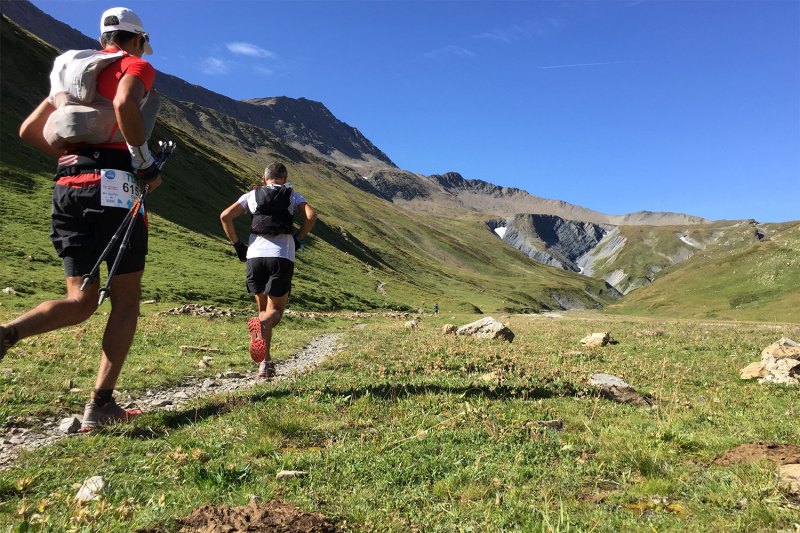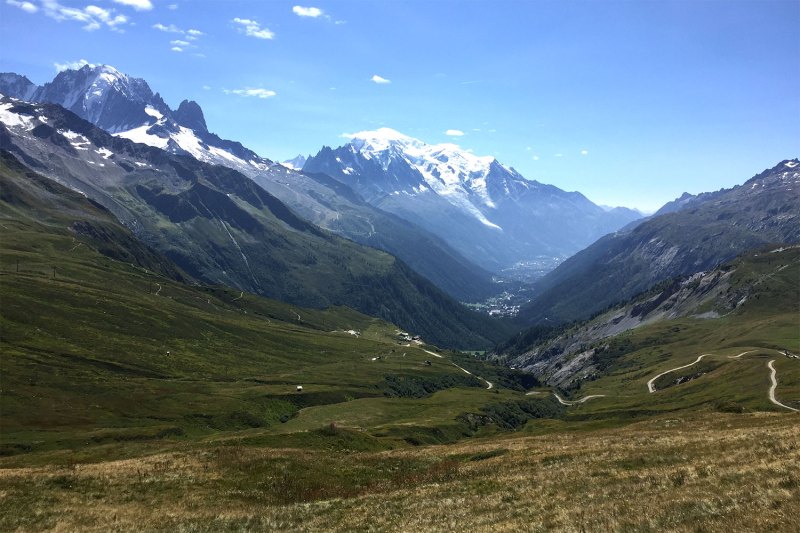When husband and wife Michel and Catherine Poletti launched the first UTMB trail race through the eastern Alps back in 2003, in the words of Catherine, they “had no hopes for it, no business plan, nothing like that.” A group of friends who shared a love for mountains and running came together and “just wanted to start something fun.” They picked the trails near the vaunted Mont Blanc simple because Michel was “a guy from Chamonix,” so that’s where the couple had settled.
Now, nearly two decades later, the Ultra Trail du Mont Blanc has grown from not just one epic trail race, but into a week-long event with multiple races through the French, Swiss, and Italian Alps and into other trail run competitions around the globe, such as a race that will take place later this year in Oman.

My experience with UTMB began when a friend named Andy Nordhoff who works for Columbia Sportswear sent me an email. Andy invited me to spend a week in Chamonix covering the UTMB races as a journalist and experiencing one of the races, the 40k MCC, as a runner. Of course, I said yes immediately, despite the fact that I had never run half that far on mountain trails before and had only a few months in which to train.
Train I did, all summer long, to the best of my ability given the realities of work, family, and all the other components of life. As I boarded the plane to head to Europe, I felt ready for the run ahead and was free of concern, but to be honest, I wasn’t sure how well I’d fare or if I’d even finish.
Now, my race is run, as are all the other epic UTMB events. The scenery has been seen, the camaraderie shared, and the invigorating, inspiring UTMB experience is ingrained into my memory. And thankfully, the lactic acid has receded from my quads. Here’s a brief recount of my experience on the trail.
The 40-kilometer (that’s 24.9-mile) MCC race, so named for commencing in the Swiss town of Marigny-Combe and ending in France’s Chamonix, a city nestled below towering Mont Blanc itself, began on a crisp, blue sky Monday morning in late August. I met up with several Columbia employees that the company — a lead sponsor of UTMB, by the way — also sponsored in the race. We would jog the first few miles more or less together. Crowded near towering navy-colored starting gate’s archway along with about 1,000 other runners, I did one last gear check (water, hiking poles, first aid kit, energy bars, spare socks, so forth), made sure to snap some pictures and pose in a few myself, checked the double-knots on my laces, stretched for the fifth time, then readied my mind for multiple hours of uphill climbs, downhill sprints, and overland slogs. With minutes to go before the start of the race, loudspeakers set around the starting pen swelled with the strains of an instrumental song that would have been right at home during the finale of a Michael Bay movie. It was perfect, really. Then came the countdown. Then came the race.

The start of a multi-hour race with hundreds of competitors departing from the narrow streets of a centuries-old town is more of a walk than a run. In this case, my fellow runners and I casually shuffled along for the better part of a mile until finally, the pack began to thin out along the ever steeper streets, many of which wound around hills thick with grape vines a few weeks shy of harvest. Around most turns in Marigny-Combe, school children had lined up to offer high fives and hearty shouts of support. (I assume they were being supportive, anyway, my French being limited to ordering beer, bread, and cheese and to asking if the person speaks English or Spanish.)
From doorways and balconies in the towns along the way and from picnic blankets and camp chairs set up at myriad points along the whole of the race, people of all ages cheered us on throughout the day, and their support was indeed welcome as the MCC snaked its way ever higher into the Alps, the trail becoming ever steeper, the terrain less forgiving, and the miles taking their toll.

I’ll not bore you with a play-by-play of my eight or so hours on the go, but I will share a few specific memories from the run that illustrate the character of a UTMB race. First, there is no beauty like that of mountains, and the mountains of the eastern Alps set the bar high for the category. At lower altitudes, lush forests are crisscrossed by glacier-fed streams and waterfalls. Higher up, grassy fields are punctuated by cobalt blue lakes and ponds while rocky outcroppings and boulders litter the landscape. As you continue to hike (even the most elite trail runners do more hiking than actual running on the steeper terrain), soon the packed dirt trails edged by grass and wildflowers give way to stone, with much the upward journey essentially a climb up natural stairs.
Two hours into the run, while my body was still feeling fine and I had energy to spare, I came out of one steep uphill section and entered a stretch of shady, even pathway lined by flowering bushes that were releasing minute white seedpods into the air. It was like running through airy snow on a summer day, and through this ethereal stretch of the Swiss Alps, I sprinted near top speed to the strains of the Oasis song “Go Let it Out.” As the trail started upward again, I took off my headphones. For the rest of the day, I went without music, preferring to hear the sounds of the trail or to share brief breathless chats with fellow runners.
“When you are running on a mountain … there is the link of mountain values. There is solidarity. You see someone on the path, you make sure they are OK.”
As Catherine Poletti would tell me the next day when we sat down for our interview, long-distance trail running truly is a sport like none other. Unlike the essentially solitary nature of other race events, during a trail race, “You meet the people running with you, you take the time to see the landscape. When you are running on a mountain,” she explained, “there is the link of mountain values. There is solidarity. You see someone on the path, you make sure they are OK.”
This I experienced time and again during the MCC. Several times when I paused to take pictures, to stretch my burning quads, or to check a shoelace or backpack strap, another runner would stop to ask if I was OK. I slowed down to check on runners who had stepped off the trail many times myself. At the food, water, and aid stations, volunteers were on hand to offer hot soup, cold water, bars, fruit, medical assistance, and lots of encouragement. You run these races yourself, but you’re never running alone.

Near the halfway mark of the run, a high point near 7,500 feet of elevation, my thighs were sufficiently aflame that I had to begin reigning in my pace to avoid cramping that could well have ended my race. Cardio-wise, I still felt great, but my quadriceps were feeling the fact that I had been relegated to training on almost pancake-flat Long Island. For the first few hours, I had passed many more runners than passed me. Henceforth, I’d be going slower and would be more often passed by. But I was fine with it; I changed my mindset and resolved to enjoy the landscape, the time spent with nothing to do but move my body, and the fact that, come what may, I was there running the best race I could run that day.
I changed my mindset and resolved to enjoy the landscape, the time spent with nothing to do but move my body, and the fact that, come what may, I was there running the best race I could run that day.
Slowing down had its advantages for my body, but also for some socialization. I had a great chat about beer with a British gentleman I met and hiked with during a particularly steep climb. I kept pace with a woman from China for several miles; we spoke not a word of shared language, but could both tell we were looking out for one another on a treacherous down climb over loose rocks and roots.
And slowing down also afforded me just enough energy for a full-speed sprint at the end. As the MCC came down out of the mountains and foothills and entered the suburbs of Chamonix, the crowds thickened. In the last few blocks of the downtown, thousands of people lined the course, cheering ever louder as each runner approached the finishing archway. Most runners set their fastest comfortable pace and stick with it right to the end; I kept a moderate pace for the last few miles, then spent everything I had left in the last few blocks. There must have been some novelty to my final dash because the cheers spiked audibly as I approached and then passed under the gate.

Entering a near fugue-state of fatigue, I bowed my head to accept a “Finisher’s Medal,” smiled for a photo, then sat down on some stone steps in the square near the finishing gate. I’m not sure exactly how long I rested there, but eventually, I made my way back to my hotel and, before even taking off my race bib, enjoyed one of the best beers of my life.
I spent the rest of the week interviewing other runners and UTMB organizers, following the arduous TDS race via van and foot (I covered the race along with a Polish photographer, Brazilian blogger, Romanian sports writer, and Finnish journalist who was also a professional runner — it was a charmingly international experience and almost a case in point example of the greater UTMB ethos), and exploring Chamonix, a city framed by the mountains both literally and in spirit.
My legs were sore for days, but I loved every minute of the experience. And, not to my surprise, I caught the distance trail running bug. Whether as a writer or a runner, and better yet as both, I’ll be headed back to UTMB as many times as I can, and to other races around the world as well.
Catherine Poletti was spot on when she said the most important thing “is to find pleasure in your race.”




